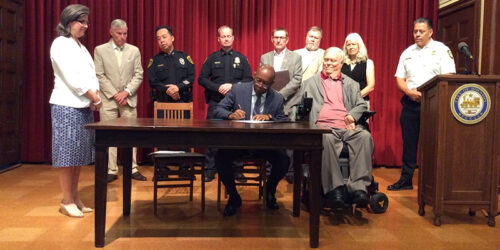Joined by mobility partners, disability advocates, law enforcement representatives and first responders, Mayor Sylvester Turner today signed an executive order to adopt Vision Zero Houston, a plan to end traffic deaths and serious injuries caused by crashes on Houston roads by the year 2030.

The policy marks a significant step in the city’s evolving mobility strategy and mirrors similar action taken by major cities around the world. Many of the cities have reported steady declines in traffic fatalities and injuries over the last few years after implementing Vision Zero.
“Some will say this goal is not achievable. But I say, “no loss of life is acceptable on our roadways, None, ZERO,” Mayor Turner said. “Together we can create change, together we can make a difference, together we can shift the way we think about mobility and traffic safety, and not only see the Vision, but make it possible.”
The plan will transform how the city designs roads and sidewalks and will prioritize engineering, education, enforcement, equity and evaluation. Mayor Turner noted that the city is already conducting road safety audits to identify and fix some of the most dangerous intersections in Houston, the construction of high comfort bike lanes to provide a safer way to travel by bike, and our new Safer Streets Initiative that will provide a coordinator whose sole job is to make our streets safer.
The mayor will establish an executive committee of leaders from city departments and our partners at the Counties, METRO and TxDOT to develop a Vision Zero Action Plan by this time next year.
“We‘ve convened some of the City’s data experts to consider the types of data needed to define the problem and establish benchmarks and make the changes necessary to make our roads safer for all Houstonians,” said Margaret Wallace- Brown, interim Planning Director. “A key component of the Vision Zero Action Plan will be shared responsibility. Every one of us must work toward zero deaths and serious injuries.”
Key organizations that will work with the city to establish the Vision Zero Action plan today applauded the mayor’s decision to focus on safer streets and engage the community to end traffic deaths and improve quality of life.
“In order to be a strong, vibrant, dynamic community where everyone can be productive and feel safe and secure, we have to stop killing and hurting ourselves on the roadways, bikeways, trail-ways and walkways of our city,” said Lex Frieden, professor of biomedical informatics, UTHealth; Board Member, Metro. “All groups, including people with disabilities and older adults, must join Mayor Turner and our community leaders in designing and carrying out a plan to reach the goal of Vision Zero.”
“BikeHouston thanks the mayor for this direction. As advocates for equity and safer streets for all, we call on the City to engage all departments, transportation agencies, non-government organizations, business representatives, and neighborhood residents to prepare and implement the Vision Zero plan,” said Clark Martinson, BikeHoustonexecutive director. “We also call on the city to prioritize dangerous streets and intersections in the CIP. Being a place with sane traffic that respects the dignity of all will make Houston the place where people will want to live, work and invest.”
Updating with Vision Zero support from Together For Safer Roads members and partners:
“This is the beginning of a new chapter in Houston and a signal moment for the Vision Zero movement,” said Noah Budnick, Senior Director of Programs and Operations at Together for Safer Roads. “We are ready to build on the work we’ve begun with Mayor Turner, our members and community partners and show new paths in the essential work to end traffic fatalities and serious injuries.”
“At Anheuser-Busch, we are committed to improving safety in the communities where our colleagues, families, and consumers all share the same roads, including here in Houston,” said Cesar Vargas, Vice President of Legal and Corporate Affairs at Anheuser-Busch. “We are proud to support Houston Vision Zero commitment because we believe passionately in partnerships that can help change behaviors and make a real difference in saving lives.”
“We believe any traffic death is one too many and we are committed to working with Mayor Turner and other partners to create streets that are safe for all residents,” said Anne Whitlock, founding director of Connect Community. “We envision a future where drivers, cyclists and pedestrians can safely share roadways, even in a neighborhood as densely populated as Gulfton.”
“Brisk Synergies is pleased to be working with Vision Zero cities like Houston to help them quickly understand the most dangerous parts of their roadways,” said Charles Chung, CEO of Brisk Synergies. “We hope to help Houston develop a safe systems approach to overall road safety and improved mobility one intersection at a time.”
“The Kinder Institute for Urban Research is excited that the community-based street safety research we conducted alongside our great partners has helped support the City’s decision to embrace vision zero. The Institute looks forward to continued collaboration as we collectively work to make our streets safer for all users,” said Kyle Shelton, Deputy Director of the Kinder Institute.
“There is nothing more important to us than safety – the safety of our employees and the communities we serve,” said Jim Olson, senior vice president of safety at Republic Services. “We believe the Vision Zero initiative will help significantly reduce serious incidents and fatalities throughout Houston and the surrounding areas, helping make Houston as safe as possible for drivers and pedestrians. We commend the Mayor and his office for championing this forward-thinking initiative.”
“Our mission is to affect positive change in cities through transportation,” said Carter Stern, LyftPolicy Manager. “We’re thrilled to partner with the City of Houston to reach its Vision Zero goal of ending traffic deaths and serious injuries on city streets by 2030, by reducing impaired driving and implementing the right solutions for safe streets.”
